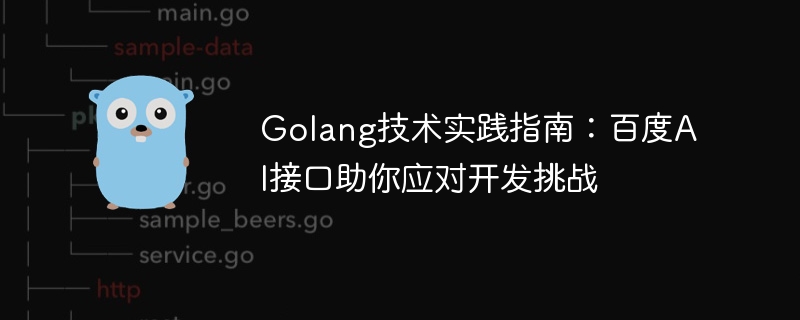Home >Backend Development >Golang >Golang Technology Practice Guide: Baidu AI Interface Helps You Meet Development Challenges
Golang Technology Practice Guide: Baidu AI Interface Helps You Meet Development Challenges
- WBOYWBOYWBOYWBOYWBOYWBOYWBOYWBOYWBOYWBOYWBOYWBOYWBOriginal
- 2023-08-13 11:06:25944browse

Golang Technology Practice Guide: Baidu AI Interface Helps You Meet Development Challenges
Foreword:
In today's Internet era, the popularity of artificial intelligence technology has made more and more people More and more developers are embarking on the road of AI development. As the leading artificial intelligence service provider in China, Baidu AI Platform has become the first choice of developers for its strong technical strength and rich service types. This article aims to introduce how to use Baidu AI interface in Golang and provide some practical code examples to help developers better cope with development challenges.
1. Introduction to Baidu AI interface
Baidu AI interface covers multiple fields, including natural language processing (NLP), image recognition, speech synthesis, etc. Through these interfaces, developers can easily use Baidu's powerful intelligent algorithms to quickly build their own artificial intelligence applications.
2. Using Baidu AI interface in Golang
-
Install Baidu AI SDK
First, we need to install Baidu AI SDK, which provides a series of functions in Golang How to use Baidu AI interface. It can be installed through the following command:go get github.com/Baidu-AIP/go-sdk/aip
-
Import the required package and set the API Key and Secret Key
Import the required package in the code and set your own API Key and Secret Key:package main import ( "fmt" "github.com/Baidu-AIP/go-sdk/aip" ) const ( apiKey = "your_api_key" secretKey = "your_secret_key" ) func main() { // 设置API Key和Secret Key client := aip.NewAipSpeech(appId, apiKey, secretKey) // 其他代码 } - Use Baidu AI interface
Next, we can use Baidu AI interface to perform various artificial intelligence operations. The following are several usage examples:
a) Text review interface
// 文本审核接口示例
result, err := client.TextCensorUserDefined("待审核的文本")
if err != nil {
fmt.Println("文本审核出错:", err)
return
}
fmt.Println(result)b) Speech synthesis interface
// 语音合成接口示例
result := client.TextToSpeech("需要合成语音的文本")
if result.ErrorCode != 0 {
fmt.Println("语音合成出错:", result.ErrorMsg)
return
}
// 保存语音文件
err := ioutil.WriteFile("output.mp3", result.ResponseData, 0644)
if err != nil {
fmt.Println("保存语音文件出错:", err)
return
}
fmt.Println("语音合成成功")c) Face recognition interface
// 人脸识别接口示例
result := client.FaceDetect("image.jpg", nil)
if result.ErrorMsg != "" {
fmt.Println("人脸识别出错:", result.ErrorMsg)
return
}
fmt.Println(result) 3. Summary
Through the introduction of this article, we have learned how to use Baidu AI interface in Golang and given some sample codes. The rich artificial intelligence interfaces provided by Baidu AI platform bring more possibilities to developers, making it easier and more efficient to build intelligent applications. I hope this article can help developers who are using Golang to develop artificial intelligence applications, so that you can deal with challenges more smoothly and efficiently during the development process.
The above is the detailed content of Golang Technology Practice Guide: Baidu AI Interface Helps You Meet Development Challenges. For more information, please follow other related articles on the PHP Chinese website!

